Imagine a bustling city, a canvas pulsating with life – the symphony of honking car horns blending with laughter from sidewalk cafes, the air buzzing with a palpable energy. This vibrant tapestry of urban life, seemingly chaotic yet intricately interwoven, has fascinated scholars and urban planners for centuries. But how do we make sense of this complex urban ecosystem? Enter the Concentric Zone Model, a pioneering theory that provides a framework for understanding the spatial arrangement of social groups and urban activities within a city.

Image: www.reddit.com
This groundbreaking model, conceived by sociologist Ernest Burgess in 1925, has become a cornerstone in urban studies, offering an insightful lens through which to analyze the dynamics of city life. In this article, we’ll delve into the heart of the Concentric Zone Model, exploring its history, fundamental principles, and contemporary relevance in a world where cities continue to evolve at a rapid pace.
A Glimpse into the City’s Heart: The Birth of the Concentric Zone Model
The Concentric Zone Model emerged from careful observation of the sprawling urban landscape of Chicago, a city experiencing tremendous growth and transformation in the early 20th century. Burgess, fascinated by the city’s dynamic socio-economic geography, noticed a discernible pattern in the spatial organization of different social classes and ethnic groups. He observed that they weren’t randomly scattered but rather clustered in distinct zones, spreading outward like ripples in a pond from the city’s central core.
Imagine a series of concentric circles, each representing a distinct zone with its own social characteristics, land-use patterns, and socio-economic profile. This model, simply yet profoundly insightful, provides a framework for understanding the intricacies of urban development, revealing the hidden forces that shape the lives of city dwellers.
The Concentric Zones: A Journey Through Urban Life
The Concentric Zone Model proposes a five-zone structure, each with its unique attributes:
Zone 1: The Central Business District (CBD): At the heart of the city lies the bustling CBD, a vibrant nucleus of commercial activity. Towering skyscrapers house corporate headquarters, bustling shops attract shoppers, and the constant flow of commuters creates a symphony of urban life. This zone represents the economic and financial heart of the city, a magnet for ambition and opportunity.
Zone 2: The Transitional Zone: Imagine a buffer zone, a space in transition, characterized by a blend of old and new. This zone, often bordering the CBD, is a melting pot of diverse cultures and economic activities. It’s a place where historic neighborhoods rub shoulders with new developments, where old factories may be converted into trendy lofts, and where a vibrant mix of ethnic communities creates a kaleidoscope of cultural vibrancy. This zone is marked by social challenges, poverty, and crime, making it a complex and dynamic space.
Zone 3: Zone of Working-Class Homes: As we move outward from the transition zone, we encounter areas primarily occupied by workers’ homes. This zone is characterized by modest, single-family homes, often clustered together in neat rows, each holding the dreams and aspirations of families striving for a better life. While the residents here may not belong to the city’s elite, their lives represent the backbone of the city, the hands that build and sustain its fabric.
Zone 4: Residential Zone of Better Residence: This zone, further away from the city’s core, reflects a shift towards higher social status and living standards. It’s where middle-class families find their haven, often characterized by well-maintained homes, manicured lawns, and a sense of community. This zone represents the aspiration towards stability, comfort, and a more relaxed lifestyle.
Zone 5: The Commuter Zone: At the city’s periphery lies the commuter zone, often characterized by suburban dwellings, quiet streets, and spacious yards. Here, residents tend to work in the city but choose to live in a more tranquil setting where life moves at a slower pace. This zone represents a desire for space, privacy, and a touch of rural serenity amidst the urban bustle.
From Theory to Reality: The Concentric Zone Model in Action
While the Concentric Zone Model presents a simplified picture of urban life, it provides a powerful tool for understanding the forces that shape the spatial patterns of cities. Its insights have been applied in various urban contexts around the world, revealing how urban areas evolve and adapt to changing socio-economic conditions.
For example, the model highlights the constant struggle for space and resources, how the CBD exerts a gravitational pull on surrounding zones, and how social class, ethnic identity, and economic forces influence residential patterns. It also provides insights into urban renewal projects, gentrification, and the impact of globalization on city landscapes.

Image: www.studypool.com
The Evolving Urban Landscape: Redefining the Model
While the Concentric Zone Model has served as a valuable framework for understanding urban dynamics, it’s not without its limitations. The model, developed in a specific historical context, might not perfectly reflect the complexities of modern cities, which are increasingly diverse and dynamic. It does not account for the rising influence of technology, transportation, and globalization on urban patterns.
Modern cities are characterized by a more intricate web of interconnectedness, with diverse social groups often clustered in non-concentric patterns. The influence of transportation networks, suburbanization, and the rise of decentralized economic activity has challenged the original assumptions of the Concentric Zone Model.
What Is The Concentric Zone Model
Beyond Zones: A New Paradigm
Despite its limitations, the Concentric Zone Model serves as a cornerstone in urban studies, offering a foundation for further exploration and understanding of urban dynamics. As cities continue to evolve, it’s crucial for urban planners, sociologists, and policymakers to understand the underlying forces that shape urban landscapes.
The Concentric Zone Model serves as a reminder that cities are not static entities but living organisms, constantly evolving and adapting to changing social and economic landscapes. By understanding the past, we can better navigate the future, ensuring that cities remain vibrant, inclusive, and sustainable spaces for all.






